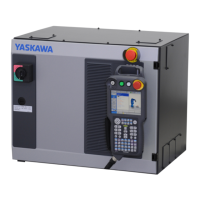HW1484764
Functional Overview
2-6
HW1484764
2.5. Escape from Clamping Function
With collaborative operation enabled, the PFL function described above puts the manipulator into a
stop position monitoring state in which it is not operable if something is clamped (stuck) between the
manipulator and surrounding environment or between the joints of the manipulator. The escape from
clamping function lets the manipulator escape from such a state.
If the PFL function performs a protective stop during collaborative operation and further the
manipulator is detected to be in a clamping state, the escape from clamping function determines which
axis of the manipulator was subjected to the highest torque and operates that axis in such a direction
that the manipulator can escape from the clamping state. During this process, the angular speed of
the axis is limited to 5 [deg/s].
When the manipulator escapes from the clamping state or the TCP's travel distance by the escape
operation reaches 50 [mm], the escape operation finishes and the manipulator goes into the stop
position monitoring state.
You can neither disable the escape from clamping function nor change the escape operation.
During the escape operation, the external force limit of the PFL function is temporarily set to the value
larger than the current external force. After the escape from clamping, the external force limit is reset
to the original setting and the job goes into the suspended state. You can resume the job from the
suspended position by pressing the resume switch to cancel the stop position monitoring state and
then pressing the [START] button.
After the escape, the
manipulator goes into
the stop position
Escape operation

